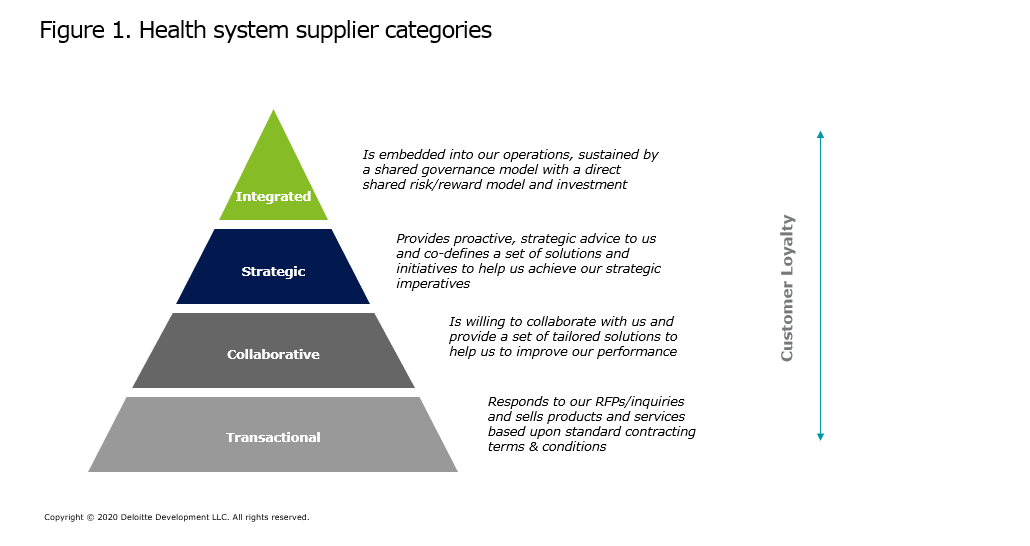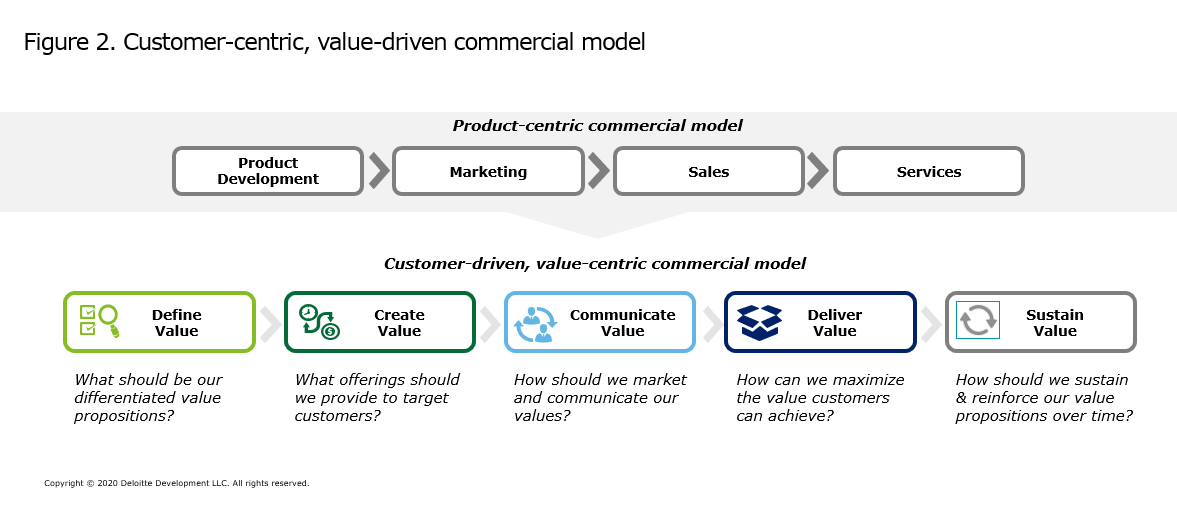ARTICLE SUMMARY:
Medtech companies that want to evolve beyond their traditional product supplier role to become a value-driven, strategic business partner to their hospital customers will need to undergo a multi- faceted transformation that addresses six success factors. By Jay Zhu, Deloitte Consulting LLP.

Deloitte Life Sciences
Comprehensive consulting, financial advisory, risk management, audit, tax and related capabilities, along with software products and platforms, deliver value at every step - from insight to strategy to action.
Whether it provides capital equipment, implantable devices, or diagnostic tests, every medtech company likes to tell customers that it is both strategic and a partner. Yet, over many years of interviews and surveys with health system executives, I have learned that very few consider their medtech vendors to be more than product suppliers.
Amid the industry’s accelerating shift toward value-based care, hospital executives are prioritizing improved financial performance, enhanced patient outcome, and care model transformation. They are looking for partners who understand their business, proactively offer new ideas, and are agile, flexible, and able to tailor solutions and engagement models. In other words, hospitals are looking for partners who can add value beyond the products they supply.
 Figure 1 illustrates how some hospitals categorize their supplier relationships. Medtech has been struggling for years to reach the pinnacle of the pyramid but despite talk about evolving the traditional product supplier role, few medtechs have made necessary, meaningful changes.
Figure 1 illustrates how some hospitals categorize their supplier relationships. Medtech has been struggling for years to reach the pinnacle of the pyramid but despite talk about evolving the traditional product supplier role, few medtechs have made necessary, meaningful changes.

To become a strategic partner and build a mutually productive and beneficial relationship with hospitals, medtechs need to undergo a multi-faceted transformation that addresses six success factors:
1. Understand customer’s jobs to be done > Understand customer’s business and value
How do you define value? Can you measure it? What are your products and services really worth to customers? Remarkably few medtechs can answer these questions because typical voice-of-the-customer studies focus on the customer’s jobs to be done rather than what the customer values. To create and deliver differentiated, higher-value solutions, medtechs must understand the underlying value customers desire across clinical, operational, economic, and experiential domains. And this understanding needs to happen at all levels of the organization, from R&D and operations to sales and marketing.
2. Develop products to get the job done > Co-create solutions that deliver value
Many executives have said, “If you see one Integrated Delivery Network (IDN), you see one IDN.” While IDNs’ overall goals may be similar—improving patient outcomes, optimizing operations, and reducing care costs—their specific needs and priorities differ. Selective medtech-hospital co-creation is, therefore, critical to deliver maximum value to each customer. Also, when customers are involved in developing the solutions they purchase, they become partners, not just buyers or users.
3. Base price on costs and margin > Base price on customer value
Value-based pricing, a strategy to set prices based on customer-perceived value, is widely recognized across industries as an effective approach to achieve increased profitability and sustained success. However, medtech has not matured on this capability. Many companies use cost- or competition-based pricing approaches that focus on products and features rather than customer value. Additionally, price erosion has become a significant challenge for many medtech companies. A long-lasting partnership must create value for both parties: Hospital decision makers understand the importance of strategic suppliers to their business and that a solution delivering higher value warrants a higher price. Medtech needs to build value-based pricing capabilities to both drive profitable growth and better communicate the value partnership story.
4. Sell products based on features and price > Sell outcomes and value based on customer needs
Customers make purchase decisions based on their perceived value of available solutions. But they often are unable to quantify a product’s impact in financial terms. Therefore, a compelling value proposition that directly addresses the outcomes customers care about, in measurable ways and backed by proof points, is essential to close the value perception gap. For example, customers likely will not pay a premium for a new pacemaker that is smaller in size. But they are more likely to pay a premium for a smaller pacemaker that reduces infection rate and length of stay. MedTech needs to sell outcomes; to clearly demonstrate that the incremental value of a product justifies its price. By doing so it creates a partnership-oriented buying situation in which the customer is less focused on the product’s price and more on how it can add value.
5. Train customers on how to use our products > Enable customer to achieve the desired value
A good supplier delivers the product on time, trains the customer how to use it properly, and provides responsive service when issues arise. Still, many medtechs leave it to the customer to figure out how to maximize value from the product. In a value-driven partnership, a medtech’s success is inherently intertwined with that of its customers. If the hospitals succeed using the product, they will continue using it, use more of it, and pay a premium for it—a classic win-win situation. This is the core concept of Customer Success, a next-generation account management approach that can help medtechs drive improved customer retention, higher revenue, increased cross-/up-sell opportunities, and lower cost to serve, leading to higher customer lifetime value. A company that implements a Customer Success strategy will need to invest in people, processes, technologies, and—most importantly—data, to identify when, why, and how customers are using its solutions, the outcomes the solutions are producing, and the best ways to help customers succeed.
6. Guarantee product performance > Guarantee value/outcomes
A true partner has skin in the game, with shared risks or rewards based on achieved value. This is the premise behind value-based contracts (sometimes referred to as outcome-based contracts or risk-sharing contracts), which can help position a medtech as trusted value partner and secure a premium price. A majority of the large, multi-year partnership deals between medtech and hospitals to date include a risk-sharing component. Furthermore, reimbursement tied to value-based payment or alternative payment models has consistently increased, making hospitals more open and willing to engage in value-based discussions with medtech. To effectively manage value-based contracts, medtechs will need to develop new capabilities such as outcome data tracking, collection, modeling, and customer change management.
Ultimately, becoming a strategic partner is about creating and sustaining value for both parties. To do this, the medtech industry will need to transition from a traditional product-centric commercial model to a customer-driven, value-centric model, as illustrated in figure 2.

Where does your company stand on the path to becoming a strategic value partner? How well do you track against these six partnership success factors? It is time to assess and determine how you should accelerate and prioritize value-focused initiatives to create stickier customer relationships.
Jay Zhu is a Managing Director at Deloitte Consulting LLP.
About Deloitte
Deloitte refers to one or more of Deloitte Touche Tohmatsu Limited, a UK private company limited by guarantee (“DTTL”), its network of member firms, and their related entities. DTTL and each of its member firms are legally separate and independent entities. DTTL (also referred to as “Deloitte Global”) does not provide services to clients. In the United States, Deloitte refers to one or more of the US member firms of DTTL, their related entities that operate using the “Deloitte” name in the United States and their respective affiliates. Certain services may not be available to attest clients under the rules and regulations of public accounting. Please see www.deloitte.com/about to learn more about our global network of member firms.
This publication contains general information only and Deloitte is not, by means of this publication, rendering accounting, business, financial, investment, legal, tax, or other professional advice or services. This publication is not a substitute for such professional advice or services, nor should it be used as a basis for any decision or action that may affect your business. Before making any decision or taking any action that may affect your business, you should consult a qualified professional advisor. Deloitte shall not be responsible for any loss sustained by any person who relies on this publication.
Copyright © 2020 Deloitte Development LLC. All rights reserved
Comprehensive consulting, financial advisory, risk management, audit, tax and related capabilities, along with software products and platforms, deliver value at every step - from insight to strategy to action.
Learn more at Deloitte Life Sciences
